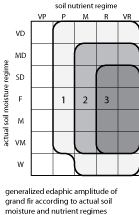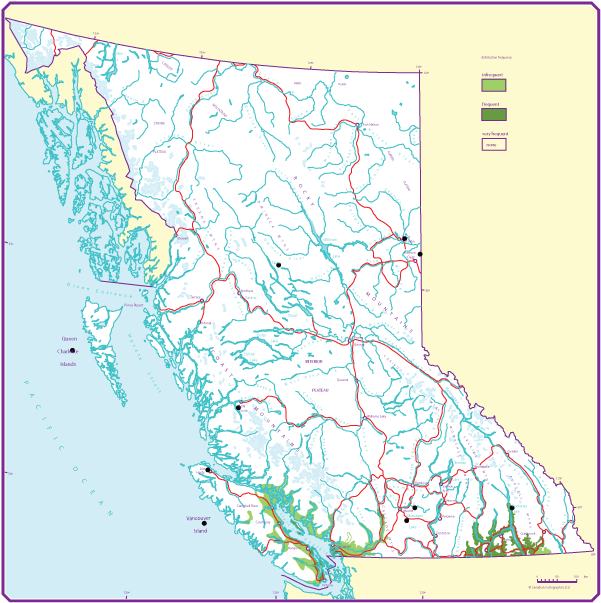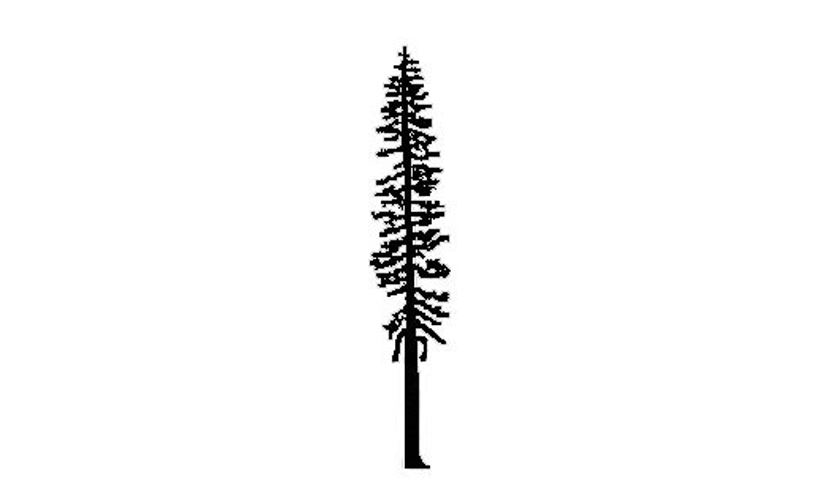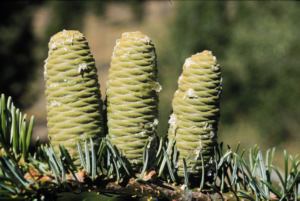Grand fir
On this page
Geographic range and ecological amplitudes
Description
Grand fir is a medium to large-sized (exceptionally >70m tall), evergreen conifer, at maturity with a low-taper stem, oval or cylindrical crown, rounded at the top, horizontal branches, and thick and scaly, gray-brown bark, separating into dark gray flat ridges. Grand fir is a valued source of soft white pulpwood.
Geographic range
Geographic element:
Western North American/Pacific and Cordilleran
Distribution in Western North America:
central and south in the Pacific region; central in the Cordilleran region
Ecological amplitudes
Climatic amplitude:
cool temperate - warm temperate - dry cool mesothermal
Orographic amplitude:
submontane - montane
Occurrence in biogeoclimatic zones:
southern IDF, southern ICH, CDF, (drier southern CWH)
In comparison with Pacific silver fir, grand fir tolerates drier and warmer climates. Thus it grows most commonly in dry mesothermal climates (mean annual precipitation 660 2500 mm) and in dry cool temperate climates (mean annual precipitation 480 900 mm), which have a fairly long growing season (about 5 to 7 months with the monthly mean temperature >10 degrees C).
Edaphic amplitude

Range of soil moisture regimes:
(very dry) - moderately dry - slightly dry - fresh - moist - very moist - (wet)
Range of soil nutrient regimes:
(poor) - medium - rich - very rich
The nutrient demand of grand fir is relatively high. It becomes more easily established in drier climates associated with less leached soils than in a wetter climate, where it is confined to soils with high levels of calcium and magnesium. Field studies indicate that grand fir grows most productively on sites with Moder or Mull humus formation.
Tolerances and damaging agents
Root system characteristics
The root system of grand fir is intermediate in development among its associated tree species. The anchoring taproot does not grow as rapidly nor as deeply as it does in ponderosa pine, common douglas, and lodgepole pine, but it grows faster and deeper than in western hemlock, western redcedar, and Engelmann spruce. Seedlings roots penetrate the soil rapidly enough in full sunlight (slower under shaded conditions) to survive drought conditions in forest floor and surface mineral soil. A relatively deep taproot enables grand fir to survive and grow well on rather dry soils and exposed ridges. On moist sites, the taproot is largely replaced by more shallow lateral roots. Grand fir roots are associated with both ecto- and endo-mycorrhizae.
| Tolerance to | Tolerance class | Comments |
|---|---|---|
| Low light | L – M | Moderately tolerant in dry climates, intolerant in wet climates. |
| Frost | L – M | Low in coastal populations, medium in interior populations; frost cracks are common. |
| Heat | M | Protection-requiring on warm and dry sites. |
| Water deficit | M | Protection-requiring on dry and warm sites. |
| Water surplus | H | Frequent on floodplains, infrequent on wet sites, frequent on sites with a strongly fluctuating water table. |
| Nutrient (mainly N) deficiency | M | Absent on very poor sites, infrequent on poor sites. |
| Damaging agent | Resistance class | Comments |
|---|---|---|
| Snow | M | Infrequent in high snowfall areas. |
| Wind | M | Low resistance when exposed by heavy partial cuts. |
| Damaging agent | Risk class | Comments |
|---|---|---|
| Fire | H | Wildfires are frequent in dry temperate climates of southern B.C. |
| Insect | H | Balsam woolly adelgid, western spruce budworm, Douglas-fir tussock moth. |
| Fungi | H | Laminated root rot, Armillaria root disease, and Indian paint fungus. |
Associated tree species and successional role
In British Columbia, grand fir grows prevailingly as a scattered, minor species in combination with one or more tree species. Pure old-growth stands of grand fir are rare. It is present in early, intermediate, and late stages of secondary succession; a minor component in old-growth stands in the CDF, southern IDF, ICH, and CWH zones.
| Associated tree species |
Occurance class | Major area of occurance |
|---|---|---|
| Western redcedar | L | Southwestern and southeastern B.C. |
| Pacific silver fir | L | Southern submaritime wetter CWH |
| Subalpine fir | L | Montane southeastern B.C. |
| Red alder | L | Submontane southwestern B.C. |
| Black cottonwood | L | Floodplains in southwestern and southeastern B.C. |
| Common douglas | L | Southwestern and southeastern B.C. |
Genetics and notes
Genetics
There are no recognized varieties of grand fir, although a green coastal form and gray interior form are often distinguished. Some evidence from field studies on young trees suggests that grand fir may hybridize with Pacific silver fir or subalpine fir in the coast-interior ecotone (Fraser, Skagit, and Skaist River valleys), however, such hybrids have not been described.
Notes
Grand fir is a very productive species — equal to or surpassing the productivity of common douglas. Its productivity results from rapid growth in early and mid-stages of stand development, large leaf biomass, moderate shade tolerance, low crown spatial requirements (high basal area), low taper, and thin bark, characteristics pertaining to the whole genus Abies. Grand fir has been successfully introduced to Europe, where it is considered one of the most productive tree species.
A desirable species on slightly dry to very moist, medium to very rich sites, preferably in mixture with less or more shade-tolerant tree species. Highly variable growth response of advance regeneration to release and susceptibility to heart and root rots make grand fir less suitable for shelterwood and selection systems. More detailed silvics information is given by:
Foiles, M.W., R.T. Graham, and D.F. Olson, Jr. 1990. Abies grandis. Pp. 52-59 in R.M. Burns and B.H. Honkala (technical coordinators) Silvics of North America, Vol. 1. Agri. Handbook 654, USDA For. Serv., Washington, D.C.
Oliver, C.D. and R.M. Kenady. (editors) 1983. Proceedings of the biology and management of true firs in the Pacific Northwest. Symposium Contribution No. 45, College of Forest Resources, University of Washington, Seattle Washington.



